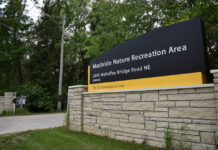A handful of small Iowa towns with populations of less than 5,000 and not part of a larger metro area bucked the trend and grew their populations in the 2020 census data just released.
These outliers come at a time when census data show Iowans increasingly living in urban areas. The growing small towns have one or more of the following working in their favor, a four-month IowaWatch investigation revealed during visits to 58 towns of 5,000 or fewer people:
- Infrastructure, such as high-speed internet, local phone and cable decision-makers, basic amenities such as good streets and lighting, and restored or replaced old buildings so that enough housing exists
- A local attraction that brings people into town to hear a story, including the arts and other recreational outlets
- Creative businesses that attract out-of-town shoppers but also embrace a sense of community pride that leads to coordinated business and local philanthropy efforts
- Readily available health care
- Adequate day care options
- Strong local schools
- A sense of being safe
- Aggressive pursuit of community development grants
- Some of these efforts can be duplicated in other towns, but success would not be guaranteed because each town has its own dynamics, experts IowaWatch interviewed said.
“A lot of this stuff is so fuzzy, it’s really difficult to tie it to one particular factor,” said Liesl Eathington, Iowa State University economics researcher and the Iowa Community Indicators Program coordinator. “The bottom line is, we can’t figure out, really, the magic recipe for growth.”
Population growth is not the exclusive measure of whether or not a small Iowa town is vital, IowaWatch found.
Denver benefits in Eastern Iowa by being near the Waterloo-Cedar Falls metro area, where jobs exist.
Denver’s 2020 census count was 1,919, up from 1,780 in 2010 and 1,627 in 2000.
“You graduate a class of 65 kids, but you have an incoming class of 85 kids,” Scott Krebsbach, Denver community school district board president, said.
Denver school district voters approved in March 2020, with 85% voting yes, a $7.75 million bond issue for a new middle/high school addition to the district’s Cyclone Center arts and athletics facility. The Cyclone Center was built after a similar vote in 2016.
All of the district’s 52 seniors graduated in 2020, giving the high school a 100% graduation rate for the year. The class scored 82% in both reading and math proficiency the previous year, when the students were juniors, state Department of Education data show.
Relying on a story
Having a story to tell helps a small town. Dyersville’s story was on full display the night of Aug. 12 when FOX Sports broadcast the first Field of Dreams Major League Baseball game from the tourist attraction just outside of town that became famous with the 1989 movie, “Field of Dreams.”
“I just think we had a very good event. Just a lot of goodwill,” Dyersville Mayor James Heavens, who watched the New York Yankees-Chicago White Sox game in Major League Baseball Commissioner Rob Manfred’s box, said.
“There’s something about the movie site and that movie that still strikes a nerve,” Mr. Heavens said about the baseball field in a cornfield where the movie was filmed. The Aug. 12 game was played on a specially built ball field near the old movie set.
Dyersville — whose 2020 population was 4,477, up from 4,058 in 2010 and 4,035 in 2000 — already had other attractions in northeast Iowa before the movie. Nicknamed the “The Farm Toy Capital of the World,” it has the National Farm Toy Museum because of the famous Ertl farm toy company that is in town and now Ertl/TOMY.
The Basilica of St. Francis Xavier church on Third Street also draws tourists to Dyersville. The result of all this is a town that can count successes other than population growth, Mr. Heavens said. The city is in good financial shape and moving forward, he said.
“Having a story to tell helps, but I think the other thing here is we really have an ability to execute plans,” Mr. Heavens said. “Even as objective as I can be, Dyersville is a very successful city.”
A little more than 100 miles south of Dyersville, Kalona markets a history that includes artisans and local Mennonite and Amish residents who bring different religious customs but also unique businesses to the area. “A lot of folks are interested in that,” Krista Hershberger, assistant director of the Kalona Chamber of Commerce, said. “It’s just such a different way of doing life.”
Ed Miller grew up in Kansas before moving to Kalona 45 years ago after marrying a woman from nearby Wayland.
“I think it’s important to the people here to understand what their heritage is, and to see it in displays,” he said.
Kalona, on the north edge of Washington County, south of Iowa City, has 2,630 residents in the new census, up from 2,363 in 2010 and 2,293 in 2000. It has a museum, several festivals and downtown businesses that cater to people interested in specialty shops.
“People like to come to Kalona because it’s a friendly community,” Ronald Slechta, publisher of the local newspaper, said.
Being a half-hour drive from Iowa City, the state’s fifth-largest city, helps Kalona because of people in that metro area who take the short drive to Kalona for its offerings.
Near Kalona, the town of Riverside created its own story: The future birthplace of the fictional Star Trek starship captain James T. Kirk.
Civic leaders made the claim in 1985 for their summer community festival, coining the name Trek Fest, after reading that Kirk would be born in Iowa in the future. Paramount Pictures, which owns the Star Trek film franchise, accepted Riverside’s claim.
But Riverside, whose population in 2020 grew to 1,060 from 993 in 2010 and 928 in 2000, also benefits from a nearby casino. The casino’s foundation provides grants for community betterment projects that include rebuilding streets and other infrastructure but also amenities tied to community aesthetics, the arts, recreation and education.
Other Iowa towns did not grow in the 2020 census, despite having local attractions. Columbus Junction, with a Tyson meatpacking plant that provides jobs and a vibrant Latino community, dropped in population to 1,830, from 1,899 in 2010 and 1,900 in 2000. Meanwhile, West Liberty, with a similar story, grew to 3,858 in 2020, from 3,736 in 2010 and 3,332 in 2000.
COVID-19 impact
Self-sustainability was helpful during a 2020 business shutdown that Iowa Gov. Kim Reynolds ordered during the start of the COVID-19 pandemic. Only essential businesses were allowed to remain open during the shutdown, and small-town businesses that relied on relatively small customer bases felt the pain.
When a longtime Parkersburg hardware store closed after 45 years, John Luhring, whose parents run a monument company, and whose brother is the city administrator, put together a business plan and started his own hardware store in early 2018. Two years later, the pandemic hit. The store remained open, deemed an essential business during the pandemic.
“It ended up being a blessing,” Mr. Luhring said. “We’ve seen an increase in sales; we’ve seen an increase in local customers coming in. And really, it made people aware.
“I don’t know how many times I heard, during the pandemic, ‘We didn’t know you were here;’ ‘we haven’t had a chance to check you out.’ The pandemic really provided people an opportunity to check out local businesses.”
Parkersburg’s 2020 census count was 2,015, up from 1,870 in 2010 and 1,889 in 2000.
State assistance
Iowa has doled out $300,000 in Rural Innovation Grants each of the last two fiscal years to rural towns and counties to fund projects that local leaders hope put a spark in their towns. All but seven of the 34 cash awards handed out in the program’s first two years — fiscals 2020 and 2021 — went to towns with fewer than 5,000 people and all went to towns of around 10,000 or fewer, state Department of Economic Development reports show.
The state funded projects like sound and lighting gear for a community theater technical training program for youth in St. Ansgar; leadership training for Latino communities in Hampton, Tama and Perry; and improvements to Chariton’s downtown square. Other projects focused on business development, aesthetics and training, as well.
Demand for the funding exceeds supply. While 22 applicants sought a total of $416,395 from the state in fiscal 2020 for local innovation projects, 64 sought $1.2 million in fiscal 2021, state reports show. That meant $3 in requests were rejected for every $1 approved. A new round of applications is being accepted for fiscal 2022, which began July 1.
Iowa established the Empower Rural Iowa Initiative for the Iowa Economic Development Authority in 2018 and later added the Center for Rural Revitalization for making rural grants. The state also has a Governor’s Empower Rural Iowa Initiative in a partnership with the Iowa Rural Development Council.
Empower Rural Iowa gives $10,000 grants to towns to conduct rural housing assessments and, in some cases, demolish dilapidated homes. Leaders in small towns interviewed by IowaWatch said they face a housing shortage.
“We have some communities that haven’t had a new house built in 10, 20 years,” Liesl Seabert, the Center for Rural Revitalization director, said in an IowaWatch interview.
Ten of the 60 towns applying in fiscal 2020 and six of the eight applying in fiscal 2021 won grants. The towns work with the Iowa State University Extension Service to determine what kind of housing they need and how to deal with factors such as zoning and housing codes to make housing available.
“It’s much more action-focused than to just produce a report that will stay on the shelf,” Mr. Seabert said. “We know it’s not solving housing, but we are helping.”
Empower Rural Iowa also has doled out more than $56 million — $50 million of that from Coronavirus Aid, Relief, and Economic Security (CARES) Act — in grants the past three years to build high-speed broadband in the state, although plenty more work remains to be done, state data show.
As much as $97.5 million is available this fiscal year in the broadband program. The state received 178 bids by the July 28 due date. An intent to award grants is scheduled for September.
The Empower Rural Iowa Task Force has made several recommendations for the program that includes developing the next generation of local business owners and to continue state funding for the rural development programs.
By Pat Kinney and Lyle Muller of Iowa Watch. Suzanne Behnke of IowaWatch contributed to this report. IowaWatch — The Iowa Center for Public Affairs Journalism – is a nonpartisan, nonprofit news outlet that strives to be the state’s leading collaborative investigative news organization. Read more or support its mission at iowawatch.org.




